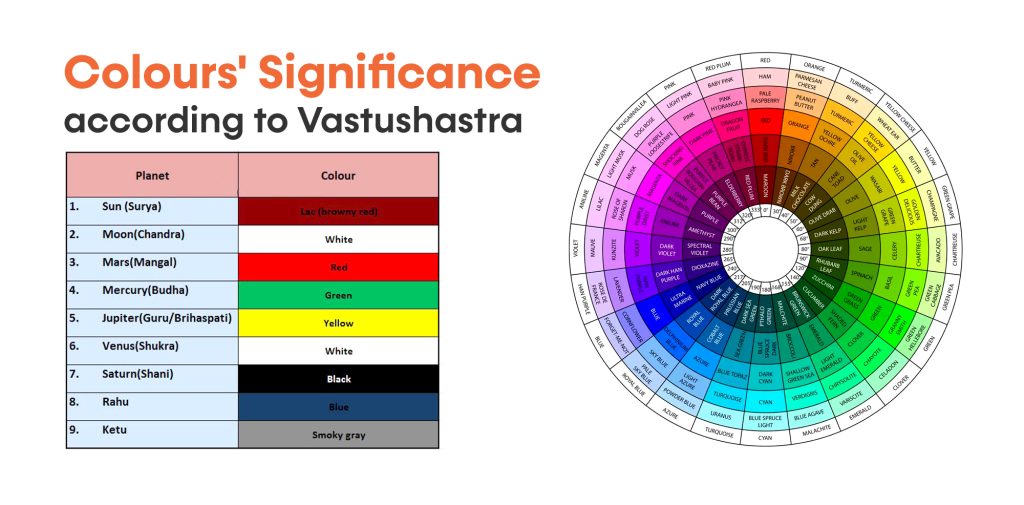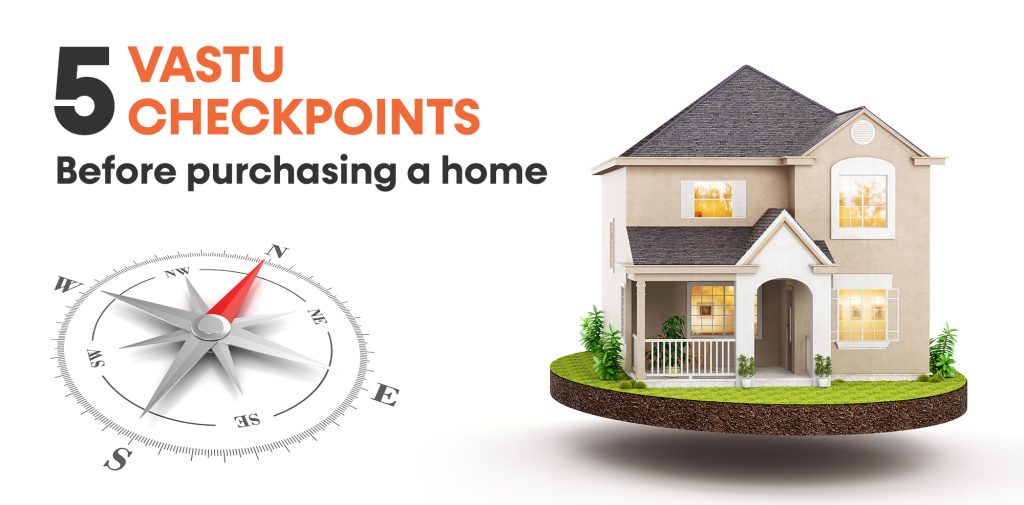According to Vastu principles, colours are very important in our homes and should never be taken lightly. Every hue has a distinct wavelength that has the power to profoundly affect our feelings, ideas, and state of mind. Colours that align with Vastu can improve our lives’ harmony when used appropriately, having a good effect on relationships, health, money, and profession, among other aspects.
The world of colour and its tremendous influence on our living places is explored in this insightful article by Vaastu Devayah Namah Expert. Find out how applying the principles of Vastu to colour selection may infuse your home with an aura of well-being, abundance, harmony, and happiness. Discover how colours may improve your life and accept the harmony they provide to all facets of your existence.
How Vastu Shastra Explains colours Effects
The Indirect Effect of Colours
The colours around us naturally draw our subconscious mind, which swiftly assimilates their qualities. How colours influence us is clear in the way that our preferences shift with the seasons. Our lifestyle changes with time, affecting everything from our wardrobe choices to the foods we eat. This includes our taste in colour. Our subconscious is permanently impacted by the colours we regularly come into contact with in our homes and offices, including wall colours, curtains, floor coverings, upholstery, and scenery.
Vastu colours for the house: harmonising with the elements
Vastu dictates that colour selection is significant, but it’s also critical that these hues harmoniously relate to the five elements—earth, fire, water, air, and space.
Earth
When stability is essential, this component is crucial. For instance, the living room, bedroom, etc. Use earthy colours, such as beige, off white, green, and brown, to balance this element. You can also include natural elements into your home decor.
Water
This element is depicted through the various tones of blue, sea green, etc. This element’s activity and colour are common in baths and bedrooms and are symbolic of calm.
Fire
Ideal for the kitchen and living area, this element represents brightness and a lot of energy. Even though the fire element is associated with colours like red and orange, it’s best to combine these hues with neutral colours to create a balanced look.
The Size
Places where this feature is most noticeable include the living room entry, the meditation room, etc. This element goes well with white, cream, and pastel colours.
Air
This element is, as its name implies, more open and in tune with nature. Easily managed colours such as pastels and lighter tones of green, yellow, and other colours. The living room is one of the spaces where this feature is most noticeable because it is open and seamless.
The colours’s Lasting Effects
Have you ever observed that anytime you take a certain scene off a wall, it leaves your eyes (or subconscious mind) feeling empty for a few days afterwards whenever you look at that wall? You eventually get used to the adjustment. Comparably, it takes some time for your subconscious to recognize a change in your room’s colours or drapes before you gradually get used to it. This phenomenon has its origins in the science and logic of the subconscious mind’s operation, which is consistent with the teachings of Vastu Shastra.
Vastushatra’s principles for colour
According to the natural elements, Vastu Shastra assigns a certain colour to each direction. For instance, blue hues work best in the North direction, which is associated with the element of water. On the other hand, we frequently encounter situations in which people have their bedrooms facing north but inadvertently add hues related to the fire element, such as red or yellow. Because of this, the North bedroom loses its beneficial qualities and is no longer in accordance with the principles of Vastu Shastra.
It is crucial to take into account the colours of the walls, curtains, floor mats, lighting, and even scenery while designing a room. Every hue has a unique effect and has the power to change the atmosphere’s energy. With the right direction and colour advice, anyone can design a space that is Vastu-friendly and enjoy a prosperous existence.
How to use Vastu Shastra to determine the appropriate colours for your kitchen, bedroom, pooja room, and house
It is common to place a high value on a property’s layout and directions, but it is also common to witness people disregarding the colour scheme of their homes and offices.
The primary influence on our ideas, which in turn impact our emotions and state of mind, comes from colours and their wavelengths. If certain parts of your life, such as relationships, health, prosperity, or career, are not in harmony, it could be because you have the appropriate colours in the proper direction.
In this post, we’ll go into further detail regarding the vastushastra’s perspective on colours and their effects on our lives, as well as which colours work best in the kitchen, living room, and bedrooms. Stay tight to the finish as we go over some easy methods to immediately start reaping the advantages of vastu shastra.
Vastu colours Tips for Your Home: A Vastu Approach to Good Energy
Your home is made to provide you with the comforts of a wealthy, productive, and healthy lifestyle. We employ Vastu Shastra to maximise the benefits that our home has to give us in terms of advancement and enjoyment. The idea that Vastu Shastra primarily applies to structural issues is a common misperception. These illusions that a home is vastu compliant if the structure is created correctly in accordance with Vastu Shastra are mostly spread by people, particularly architects and interior designers.
But in the end, this is a completely bad plan that will cause problems for the people. Our goal is to educate people about the logic, facts, and realities of this wonderful discipline.
Vaastu Bedroom colours for Children
Having children makes it difficult to fulfil their requests. But with your art, you go to tremendous lengths to satisfy them. Make the entire area more suitable for organising and carrying out operations by using anything from carton-textured paint to soothing colours. representative of the growth, contentment, and capacity for optimism of your kids.
Select Vastu hues for your kitchen.
According to Vastu Shastra, one of the most significant aspects to consider inside a kitchen is its colour scheme. Choosing the kitchen’s best colour based on Vastu is highly advised. Numerous individuals sometimes overlook this, which frequently results in converting an otherwise flawless Vastu kitchen into a Vastu Dosha (Vastu Defect).
The beneficial elements of a kitchen are negated if the colours chosen do not align with Vastu Shastra, even if the kitchen is oriented perfectly. We have seen a lot of instances when people believe that having their kitchen (fire element) facing southeast is the right orientation according to Vastu Shastra.
They do, however, intend to follow the trend and install blue lighting or a black granite marble surface in the kitchen. We can no longer refer to the South-East kitchen as a Vastu compliant home because this destroys its beneficial features.
We advise kitchen wall colours that are in harmony with Vasu, such as beige, cream, and other neutral hues that do no harm in either direction. The best time to choose a colour for a kitchen slab and other kitchen appliances is to evaluate the layout map and consider the particular direction in which the kitchen is located. One needs to speak with a Vastu professional rather than relying just on Google to follow Vastu guidelines for kitchen colour.
Different colour schemes are advised for each direction, and a skilled Vastu Consultant can provide guidance based on the layout of the house. Should the colour scheme not follow Vastu principles, our specialists might suggest applying Vastu colours to the kitchen to counteract the negative effects of colour schemes without requiring any structural changes.
Vastu Shastra-inspired colours for Pooja’s room
The pooja room’s colour scheme is similarly crucial, and any mismatched or non-vastu compliant hues could detract from the beneficial aspects of that direction. According to Vasu Shastra, colours in shades of golden, pale yellow, white, or cream are recommended for your pooja room’s exterior as well as inside. These tones elevate those directions’ qualities even further, putting us in a more advantageous position.
Using red hues in the puja room—regardless of the room’s direction—is a major myth according to vastu. Red denotes the fire element, as we have learned, and the presence of red in the pooja room indicates the presence of the fire element there. Nonetheless, the North-East direction—which is regarded as the house’s brain—is the most optimal and frequently chosen for the pooja room. The brain of the home is where the fire element is added when red or the fire element is added in the north-east direction. The fire qualities will therefore manifest as hostility and disruption to the occupants of that area, leading us to believe that Vaastu Shastra isn’t serving our needs.
Vastu Living Room colours Schemes
Vastu Shastra dictates that a home’s colour schemes must be followed throughout for it to be wealthy. The pleasant vibes of the entire room can be raised simply by arranging the wall colours in accordance with vastu. For a living room, cream, off-white, and beige are the Vastu Shastra hues. Multicoloured living room ideas need to be implemented under the skillful direction of a qualified vastu specialist.
A single hue might not be the greatest choice for the remaining directions because living rooms frequently occupy many directions. Neutral colour schemes are therefore the greatest choice in these circumstances. It is important to take into account not only the colours of the walls but also the colours of the curtains, paintings, carpets, floors, furniture, etc. It has been noted that choosing colour schemes in accordance with vastu shastra has the same impact as choosing a vastu-perfect building.
Vastu-Recommended colours Schemes for Bedrooms
Selecting the appropriate colours for bedrooms is a crucial component of Vastu Shastra.
- Our bedrooms are where we spend six to eight hours of the day on average. The vastu equilibrium of your home may be thrown off if your bedroom has unsettling colours. For instance, a bedroom facing west is most suited for business travellers. The west is known for its financial success, earnings, and profitable ventures.
- The greatest advantages cannot be guaranteed by simply having a bedroom facing this direction unless your colours palette complies with Vastu. The good aspects of the west direction are lost if a bedroom has red or green hues, representing the fire or air elements, and the occupants will not experience the luxury of a vastu-compliant bedroom.
- Our vastu specialists have seen and experienced firsthand that when a customer chooses their bedroom colours in accordance with vastu, the pair experiences love and prosperity in their relationship. Couples should first choose the colours of their bedroom based on their preferences, making sure, however, that no bright or garish hues are chosen.
- By simply aligning the hue of the master bedroom according to vastu shastra, an experienced vastu consultant can maximise the positive aspects of your home and eliminate the need for renovations or reconstruction. To guarantee that there is no misalignment with Vastu Shastra, neutral, bright, and pleasant colours schemes, such as off-white or cream, are often advised for couples’ bedrooms.
Therefore, it is crucial that we choose our bedroom’s colour scheme in accordance with vastu shastra and consult a professional vastu consultant.
Fast Colour Advice Based on Vastu Shastra
Use warm, soft colours that provide a nice effect whenever possible.
According to Vastu, use relatively light colours, especially in the bedrooms.
- When choosing colours for a room, Vaastu Principles should be followed to ensure that the area is in harmony with natural laws.
- According to Vastu Shastra, objects or scenery, etc. that symbolise a certain element should be arranged in the direction for which it is intended.
- Stay away from utilising red hues in your space’s north-east direction when choosing curtains, lighting, etc. Aggression in the home could result from it.
- The qualities of a given direction are enhanced when artificial flowers of that colour are arranged according to their elemental Vastu direction.
Guidelines for Choosing Curtain colours
- According to Vasu, the colours of the walls and every space are considered when choosing the colours for your home. Pastel-coloured curtains (white, off-white, cream, golden, etc.) are a nice choice. These colours are a wonderful option for a bedroom since they encourage calm and harmony, in accordance with Vastu principles. Vastu dictates that if your bedroom is shared with your partner, you should not hang any black curtains or anything that closely resembles black.
- Depending on the way the living room faces, the curtains in that space should be yellow, green, or blue. If the dining room is oriented toward the south or southeast, the colours chosen should match the Vastu colours for the house, which are pink, brown, or green. Fresh starts are symbolised by colours like blue and romance is represented by pink. Vastu states that bathroom drapes should be white, cream, and golden.
- Use Vastu colour theory to guide the placement of artwork on the northeast wall. You would benefit from avoiding red and black. According to Vastu, the paintings and portraits that are hung on a wall have equal significance as the colour scheme chosen for the space.
Wall colours according to Vastu Principle
The orientation of your house is a major factor in choosing the right wall colours when it comes to Vastu colours for homes. Certain colours are linked to each direction, which helps improve the harmony and positive energy in your living areas. Here is a thorough breakdown of the Vastu colours for walls according to their direction:
North
Green is the best colour for walls facing north since it denotes richness, growth, and wealth. It is connected to the water element, which stands for rebirth and life. You may promote harmony and balance in your home and attract prosperity and success by painting the walls facing north or north-east green.
East
White is suggested for walls facing east, as it represents enlightenment, purity, and fresh starts. The air element, which denotes intelligence and knowledge, is connected to the east direction. White paint on your east-facing walls can promote openness and clarity, which will boost positive thinking and intellectual development.
South
If you want to add warmth, energy, and vigour to walls facing south, choose red and yellow. Fire, an element that symbolises passion, bravery, and metamorphosis, is connected to the south. Yellow denotes joy and optimism, while red represents strength and power. If you use these colours on your south-facing walls, your house will seem more vibrant and energising.
West
Blue, this colour, which denotes harmony, peace, and emotional equilibrium, is ideal for walls that face west. The earth element, which denotes solidity and grounding, is connected to the west direction. You can foster a calm and serene atmosphere that encourages relaxation and emotional well-being by painting the walls of your home that face west blue.
New England
Though they encourage spirituality, serenity, and heavenly guidance, white and light blue are lucky colours for northeast-facing walls. According to Vastu Shastra, the northeast is the most auspicious direction since it is linked to enlightenment and spiritual development. By using these colours on your northeast-facing walls, you may establish a tranquil and peaceful environment that is ideal for reflection and meditation.
Southeastern
Silver and light grey are excellent choices for southeast-facing walls because they signify elegance, refinement, and modernism. Fire is a creative and passionate element that is connected to the southeast direction. Applying silver or light grey paint to your southeast-facing walls can elevate your home’s aesthetic and encourage creative expression and ingenuity.
Southwestern
Warmth, cosiness, and solidity are created by the hues peach and light brown, which work well on walls facing southwest. Earth, the element that represents solidity and grounding, is connected to the southwest direction. You can foster a warm and inviting atmosphere that encourages emotional stability and security by using these colours on your southwest-facing walls.
The Northwest
For walls facing northwest, light grey and white are suggested because they represent mental clarity, purity, and focus. The element of air is linked to the northwest direction and represents intellectual development and communication. Painting the walls of your home that face northwest white or light grey can promote clear thinking and open communication, which will promote positive relationships and personal development.
By adopting the proper Vastu colours based on the orientation of your walls, you may improve the positive energy flow, balance, and harmony in your home, creating a dynamic and nurturing living atmosphere for you and your loved ones.
Also Read – Investing In A Flat Or House: A Comprehensive Guide
Also Read – Important Considerations For Buying Real Estate In India
Conclusion
In our day-to-day existence, colours are significant. A pleasant, blissful, and positive vibe can be created by using the right colours in the right places, which promotes joy in life. When you adhere to the specified colour rules, using colours to achieve the intended consequences or outcomes is simple. According to Vastu shastra, painting the walls can significantly improve the house’s ability to attract riches, bring about harmony, and preserve wellbeing. You can take use of the restorative, revitalising, energising, and nurturing qualities of colour in your home by consulting a qualified Vastu shastra specialist. For rental inquiries visit Lets Rentz .



